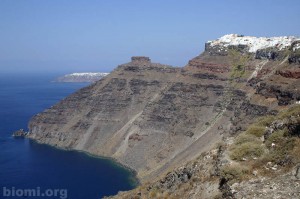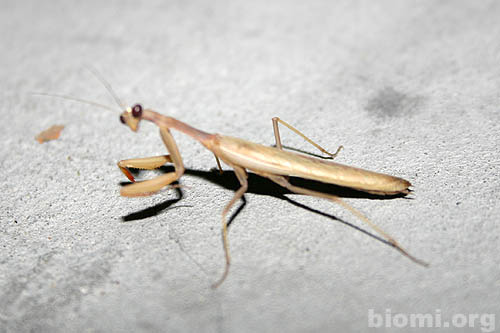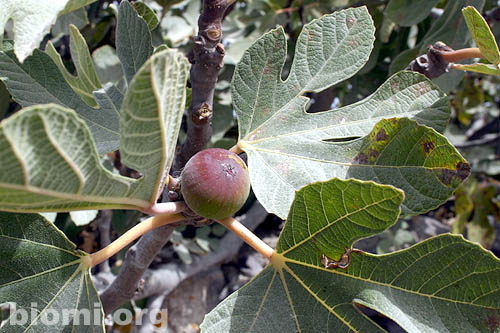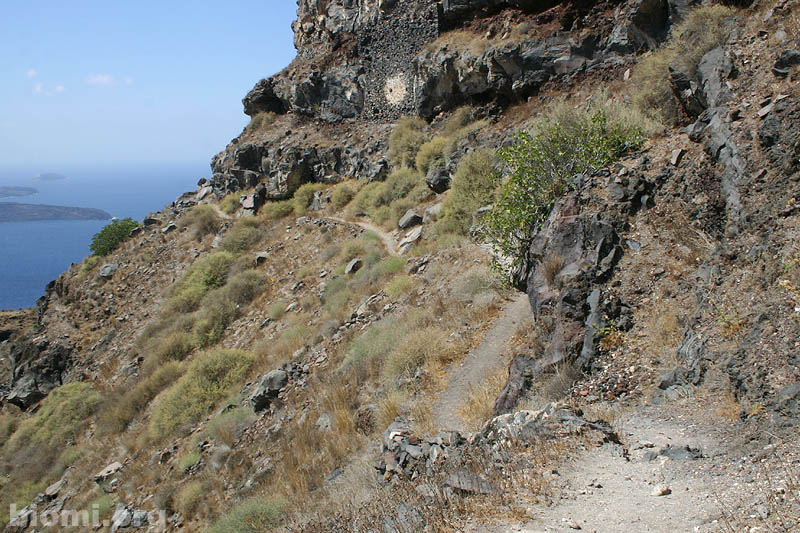 Introduction
Introduction- Miscellaneous Information
- Birds
- Other animals
- Vegetation
- Nature Trails
Santorini is a small volcanic island group in the Aiegean archipelago, Greece (see location and a local map). It consist of five islands: Thira (the main island, sometimes spelled Thera), Thirasia (Therasia), Aspronisi, Nea Kameni and Palea Kameni. The two latter ones are fairly new volcanic islands on the middle of the group, while the other three from a circle around them, enclosing the Caldera.
This report describes the nature of Thira and Nea Kameni, as we observed it on out trip in August 11-18 th, 2006. We stayed at Imerovigli, so most of the observations are from that area.
Santorini’s flora and fauna is less diverse than on most other islands of Greek archipelago. It is small and arid, and located on the southern edge of the Aiegean island group, quite far away from mainland. Most of the land area is inhabited of cultivated. There is roughly 10.000 inhabitants on Thira and 200 on Thirasia. Between spring and autumn Thira is full of tourists.
Miscellaneous information
The weather on Santorini is warm and sunny between spring and autumn. Most of the rain comes in winter. In September, the weather is warm and sunny but usually windy. Wind blows mainly from north or northeast. Ocean is usually covered with mist, so visibility is less than ten kilometers and the famous sunsets are not that spectacular.
Contrary to many (older?) tourist guides, English is widely spoken, especially among younger people.
Local buses run between major villages. Usually the destination is written also in english and/or yelled by the driver. On tourist season the buses can be crowded and not on schedule.
Vegera at Imerovigli is a good traditional restaurant (or tavern) with excellent food.
The capital city (or village) of Santorini is Fira (sometimes spelled Thira).
Knowing greek alphabet is helpful i.e. for knowing where the buses go.
The narrow alleys of Imerovigli are worth to walk through.
Birds
Illegal bird trapping is a problem on Santorini, according to Birdlife International. Tens of thousand of migrating birds are caught annually. We didn’t directly observe bird trapping, but saw few trapped Greenfinches and a European Goldfinch.
We also observed hunting on the island, plus found some shotgun cartridges on rural roads. Illegal hunting is a known problem on some Mediterranean islands (namely Malta and Cyprus), but I don’t know what the situation is on Santorini.
A list of species observed
A total of 33 bird species were observed (if the Quail is not counted). See observations in detail at Hatikka observation database (if you know the scientific names). All the birds except one unidentified swallow were observed on the island of Thira.
Common Quail (Coturnix coturnix)
One individual heard briefly at Fira. Probably caged bird.
Cory’s Shearwater (Calonectris diomedea)
Seen twice at Imerovigli on a flock with Yellow Legged Gulls feeding on schools of fish (one and 36 individuals). (see Yellow-Legged Gull)
European Shag (Phalacrocorax aristotelis)
Seen twice at Imerovigli with Yellow Legged Gulls feeding on schools of fish (two and one individuals). (See Yellow-Legged Gull)
Common Kestrel (Falco tinnunculus)
Probably the most common raptor on the island, but hard to tell apart from Lesser Kestrel (wich we didn’t see though). We saw Common Kestrels and unidentified Kestrels on ten occasions.
Eleonora’s Falcon (Falco Eleonorae)
A pair north of Oia and a single bird at Oia on September 13 th, and two at Fira on the following day. All were circling in raising air currents alongside precipices.
Peregrine Falcon (Falco peregrinus)
One at Imerovigli on Sptember 14 th and at Fira on the following day. Also a flock of three large falcons at Mesa Vouno mountain near Perissa on September 15 th; one of these were identified as a peregrine before the birds flew out of sight.
European Honey Buzzard (Pernis apivorus)
One bird at Mesa Vouno mountain near Perissa. In Malta, Honey Buzzard and Marsh Harrier are the most abundant migrating raptors, so perhaps more birds of these species could bee seen also at Santorini in autumns.
Eurasian Sparrowhawk (Accipiter nisus)
One bird along the Caldera precipice on September 12 th.
Long-legged Buzzard (Buteo rufinus)
One individual seen twice on subsequent days (September 16-17th) on the precipice at Fira.
Eagle
One fairly small, unidentified eagle seen briefly on the precipice at Fira on September 16th.
Yellow-legged Gull (Larus michahellis)
Common in the Caldera. On few mornings we saw flocks of Yellow-Legged Gulls feeding on small fish (flocks had 50-200 birds). As we learned at the end of our holiday, these flocks should be carefully examined for other fish-eating species, such as Cory’s Shearwater and European Shag. A telescope is needed as the cliff near Fira and Imerovigli is about 300 meters high.
Feral Dove (Rock Dove) (Columba livia)
With House Sparrow, Feral Dove was the most commonly seen species on the island. Largest flocks we saw had 50 and 60 Feral Doves. Many of the birds are partly or mostly white.
Eurasian Collared Dove (Streptopelia decaocto)
Some were seen at Fira and Imerovigli, plus one at Perissa and at the countryside north of Oia. A total of about ten individuals observed.
Little Owl (Athene noctua)
One seen lurking for prey during daytime at Skaros rock, Imerovigli.
Alpine Swift (Apus melba/Tachymarptis melba)
A flock of four to five birds seen above Perissa.
Common Swift (Apus apus)
Few individuals were seen at Imerovigli, mostly in the evening around sunset (c. 7.30 PM).
Red-backed Shrike (Lanius collurio)
Four individuals at three locations (Imerovigli, Oia, and Perissa), all on rural land at the edges of settlements.
Hooded Crow (Corvus corone cornix)
Common around the island. The largest flock had about 30 birds.
Common Raven (Corvus corax)
Few birds were seen daily along precipices and mountains all over the islands. Ravens probably nest on the precipices.
Barn Swallow (Hirundo rustica)
Two to six individuals were seen daily, especially around settlements. Also some unidentified swallows were seen, most of them probably Barn Swallows. The only bird we observed at the island of Nea Kameni was a swallow passing by.
Eurasian Crag Martin (Ptyonoprogne rupestris)
This species seems to favor sunny cliffs and precipices, where it preys on insects. The most reliable site to see Crag Martins on our trip was the hillside next to Skaros rock in Imerovigli few hours before sunset. In the mornings the birds were absent. Also few were seen at a Mesa Vouno mountain and a precipice at Perissa (opposite the bus stop) and around Imerovigli.
Common House Martin (Delichon urbicum)
Two seen at Imerovigli on September 11th.
Crested Lark (Galerida cristata)
The most abundant species on rural area north of Oia: about 15 individuals seen or heard during a few hours walk. Also one heard between Imerovigli and Fira. This species is probably one of the most abundant species outside settlements (except in wine plantations?).
Hippolais-warbler
One probable Eastern Olivaceous Warbler (Hippolais pallida) seen on a bush at Imerovigli.
Willow Warbler (Phylloscopus trochilus)
Few seen feeding in bushed around Imerovigli. Additionally, an equal number of unidentifiedPhylloscopus warblers at Imerovigli and Fira.
Lesser Whitethroat (Sylvia curruca)
One was seen at Imerovigli and one north of Oia. Additionally one Lesser Whitethroat or Subalpine Warbler female at Imerovigli, but the bird eluded identification.
Whinchat (Saxicola rubetra)
One individual on wine plantations at Imerovigli.
Isabelline Wheatear (Oenanthe isabellina)
One individual on a barren field just north of Oia.
Blue Rock Thrush (Monticola solitarius)
A total of eight birds (plus few probable ones) observed at four locations around the island, usually on steep cliffs or precipices.
Spotted Flycatcher (Muscicapa striata)
One was seen at Imerovigli and one north of Oia.
House Sparrow (Passer domesticus)
With Feral Dove, House Sparrow was the most commonly seen species on the island. Flocks of 10-20 birds were often seen around Fira and Imerovigli. Biggest flock had at least 50 birds.
Yellow Wagtail (Motacilla flava)
A lock of five was observed north of Oia plus one at Imerovigli. Migrating birds stopping by.
Tree Pipit (Anthus trivialis)
Two birds were heard. Migrating birds stopping by.
Common Linnet (Carduelis cannabina)
One bird heard on two occasions at Imerovigli.

A flock of Yellow-legged Gulls and Cory’s Shearwaters on the Caldera (digitally enchanced).
Suggested birding locations
As far as I know, there aren’t any real birding locations on the islands (no any kind of wetlands, no forests etc.). Instead I suggest some places that could produce interesting obrservations.
Sea on the calm side of the island (usually inside the caldera)
There may be schools of fish attracting Yellow-legged Gulls and other fish-eating birds.
Wooded areas
There are no trees growing naturally on Santorini, but bushes and planted trees are fairly common. Groups of trees could attract passerine birds. There was one larger wooded area in Perissa (probably the backyard of a hotel).
The coast on the windy side of the island
When wind hits the island’s steep coast it raises upwards. The raising air current may attract birds of prey. We saw most of the Eleonoras and Peregrine falcons in places like this. Wind blows mainly from north and northeast, so the coast north of Oia and the Skaros rock at Imerovigli could be good places.
Agricultural areas, except for wine plantations
Rural area north of Oia produced interesting birds, whereas the wine-growing area next to Imerovigli seemed to have fewer birds.
Southern tip of Thira
We didn’t see any clearly migrating birds, but if there were some, they could concentrate to the southern tip of the main island (especially if there was a wooded area).
Dumping area
Are there any on the islands?
Fish harbors
Are there any on the islands? The harbor of Fira didn’t seem to attract gulls.
Other animals
Noctule bat (Nyctalus noctula)
Possible Noctule at Imerovigli. We heard a high-pitched sound that could be a Noctule. It’s the only European bat which can be heard with human ears while it’s hunting.
Erhard’s Wall Lizard (Podarcis erhardii)
We saw many wall lizards around Thira, most abundantly on the hillside of Mesa Vouno. Both individuals that we photographed and identified were Erhard’s Wall Lizards, a common species on the area.
Invertebrates
- Hummingbird Hawkmoth (Macroglossum stellatarum): two seen feeding on garden flowers at Imerovigli and Fira.
- Swallowtail (Papilio machaon): six individuals seen around Santorini.
- Brimstone (Gonepteryx rhamni): one between Imerovigli and Fira
- Red Admiral (Vanessa atalanta): one at Imerovigli.
- Painted Lady (Vanessa cardui): one stopped by at Nea Kameni volcano island.
- Praying mantis (order Mantodea) one night on a street at Imerovigli.
- Unidentified invertebrates: a large spider, a blue winged bumblebee and many cicala.

An unidentified praying mantis (order Mantodea).
Fish
On few mornings we saw dense flocks of Yellow-legged gulls swimming on the Caldera around Imerovigli. A bit later we found out that there was a school of large fish (perhaps tuna?) hunting on a school of smaller fish. The gulls (with shearwaters and shags) were feeding on the smaller fish, which were jumping in the air while trying to escape from the preying fish. Quite a sight seen on clear blue water from 300 meters above!
Vegetation
Most of the rain comes in winter, so spring is the best time to see fresh flowers and other plants. In autumn many of the plants are dried out. Circa 600 species of plants are identified from Santorini.
There are no naturally-growing trees at Santorini, due to volcanic activity and small rainfall. Typical Mediterranean and decorative trees and shrubs are common as planted, especially around settlements. These include i.e. Common Fig (Ficus carica), Olive (Olea europaea), Oleander (Nerium oleander) and different Pines (Pinus spp.) and Eucalypti (Eucalyptus spp.). Rarer species are i.e. the Norfolk Island Pine (Araucaria heterophylla), Common Ironwood (Casuarina equisetifolia) and Pomegranate (Punica granatum). Brazilian Tree Tobacco (Nicotiana glauca) is a common escapee around Santorini.

Common Fig is perhaps the most common tree on Santorini.
Nature Trails
To my knowledge there aren’t any official nature trails or hiking paths at Santorini. Here are few interesting paths we found (walking on your own risk):
Paths at Skaros rock, Imerovigli
The Easiest way to Skaros is the stairs behind the Blue Note restaurant at Imerovigli (just follow the Blue Note -signs, can’t miss them). Most of the paths were fairly easy to walk, but if you’d like to climb to the top of Skaros, prepare with a fearless mind: some vertical climbing is needed (photo).
Mountain path from Perissa to Ancient Thera (and to Kamari from there?)
A steep footpath that climbs from Perissa to the Ancient Thera between the Prophitis Ilias and Mesa Vouno mountains (photo). Donkey-rides are occasionally available.
The (so-called) nature trail from Imerovigli to Oia
We didn’t walk this path through, but heard it being popular. Large part of the trail follows ordinary roads and is quite unnatural, but offers great views of the Caldera. The trail starts at the Ampelonas-hotel at Imerovigli.

Yksi kommentti
1. Andrew Lissner, PhD
Andrew Lissner, PhD
I very much enjoyed and appreciated your article. As a professional biologist and visitor to Santorini in October 2014 I was dismayed at the lack of much information on the several bird species I observed until I came upon your information. Very helpful; nice contribution.
Regards.
Andrew Lissner
Tämän jutun kommentointi on suljettu.